|
|

| |
| |
The temple of Queen Hatshepsut in Luxor
By Seif Kamel
|
| |
In a spot sacred to the goddess Hathor in the West Bank
of Luxor, situated under the foot of one of the huge
Theban Mountains, the Queen Hatshepsut has built her
mortuary temple that was so fascinating that was called
many names in ancient times. One of these names was "The
splendor of splendors". |
| |
| |
| |
|
| |
|
Who was Queen Hatshepsut |
|
| |
Hatshepsut was the first
queen to rule over Egypt in the ancient Egyptian
history. Despite the fact that there were many people
and royal members who objected the idea of having lady
to rule over Egypt, she was able, through her many
achievements to prove her abilities to be one of the
most important and successful rulers of Egypt throughout
history.
Hatshepsut was the daughter of king Tuthmosis III, who was an important
army leader during the reign of the 18th dynasty.
However, Tuthmosis III didn’t have the royal right to be
the king of Egypt. This was because he didn’t belong to
the royal family as he was a noble who married a royal
princess, Ahmose, the mother of Hatshepsut.
By marring the royal bride, Tuthmosis III was able to
declare himself as the king of Egypt. However after the
death of the mother of Hatshepsut, he had to step down
and there were many complicated debates concerning who
would rule Egypt after him. The Royal court at the time
decided that Hatshepsut, who was a royal princess,
should be the legitimate ruler of Egypt.
When Hatshepsut became the queen of Egypt, she wanted to
prove to all the people that they took the right
decision to make her the ruler of Egypt. This was why
she started a process of internal reforms that included
digging canals to enable the irrigation water to reach
more lands to be cultivated. She restored many of the
temples that were constructed in later periods.
Hatshepsut has also started a series of trading journeys
especially to the lands of Punt to export wood and
perfumes to be used in Egypt. Her mortuary temple,
located in the West bank of Luxor is the strongest
evident on how strong and successful she was as the
first queen to rule over the land of the Nile. |
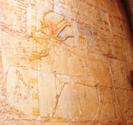 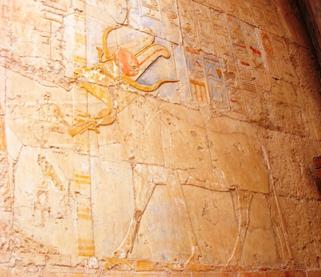
|
| |
| |
| |
|
The discovery and the name of the temple of Hatshepsut |
|
| |
Although travelers
visiting the West Bank of Luxor in the 19th century gave
exact details and descriptions of temples like the
Ramesseum and the Temple of Madinet Habu, they have
never mentioned anything about the mortuary temple of
Hatshepsut.
This was probably because the temple of the great
ancient Egyptian queen at that time only consisted
mainly of a pile of dust and ruins on which a Christian
monument was established.
This large Christian structure that was established in
the same location of the temple of Hatshepsut gave its
name to the site.
The whole complex was called "Al Deir Al Bahry", or the
Northern Monastery in the Arabic Language, for a very
long time and some people still, until today, use this
term to refer to the temple of Hatshepsut.
|
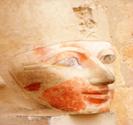 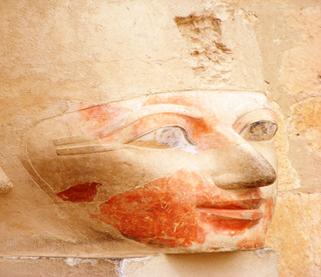
|
| |
|
|
The
discovery of the Temple of Hatshepsut |
|
| |
It wasn't until 1858,
when Auguste Mariette, the famous founder of modern
excavations in Egypt, led a mission to unearth the
structures of the mortuary temple of Queen Hatshepsut.
Other archeological excavation missions, including these
of Eduard Naville in 1891 and Herbert Winlock in 1931,
that were trying to reveal the secrets of the Temple of
Hatshepsut, were able to discover the ruins of the most
ancient temple built in that spot which is the temple of
Mentuhotep II, the founder of the 11th dynasty.
In 1961, a Polish Egyptian mission has began the
excavation work once again discovering the ruins of the
mortuary temple of Tuthmosis III. The scholars belonging
to this mission were able to discover all the wonders
that we see today when we visit the Temple of Hatshepsut
or El Deir Al Bahry Complex
Queen Hatshepsut, the only lady to rule over Egypt as a
pharaoh, was very wise when she chose senenmut, a high
governmental official in her region, one of the
cleverest architectures in ancient history, and the
tutor of Nefru Ra, the only daughter of the queen
Hatshepsut, to construct her mortuary temple. This
temple, when it was built between the periods from 1480
to 1455, it was extremely divine for all the ancient
Egyptians that they even called it "the sacred of
sacreds". |
 
|
| |
| |
|
The description of the temple of Hatshepsut |
|
| |
The temple of Hatshepsut
mainly consists of three trances ranging in levels with
the first one constructed at the facade of the temple,
the second which is called the upper terrace was built
on the second floor, and the third which is the highest
contains the sanctuary of Amun to which the temple was
dedicated together with the god Re-Herkhaty. |
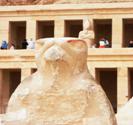 
|
| |
| |
|
The Punt
Portico |
|
| |
The most interesting and
most visited part of the temple of Hatshepsut is
so-called punt portico. Located in the Southern part of
the colonnade that closes the second terrace, this
section of the temple is truly fascinating.
The drawings and colorful scenes carved on the walls of
this part of the temple illustrate an expedition mission
that went to the land of Punt, near Nubia, during the
rule of the Queen Hatshepsut. The main objective of
this expedition mission that consisted of five huge
ships was to obtain perfumes and wood from these lands
to be used in the land of the Nile.
History tells us that more than thirty Myrrh trees were
transported from the land of Punt to Luxor to be
transplanted in the Karnak Temple
|
 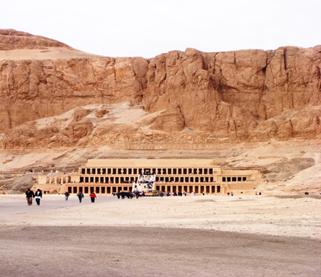
|
| |
| |
|
The
Chapel of Hathor |
|
| |
One of the most
significant and beautiful elements of the temple of
Queen Hatshepsut in El Deir Al Bahry Complex in the West
Bank of Luxor is the chapel of Hathor. It lies directly
to the south of the Punt Portico.
The chapel of Hathor consists of six pillars decorated
with the Hathor capital on top, eight huge decorated
columns, and a hypostyle hall that includes 12 columns.
Afterwards, the guest reaches the sanctuary, which is
not open for pubic now, and where many of the secret
ceremonies dedicated to the worship of the Hathor, the
goddess of love, pleasure, and beauty in ancient Egypt,
took place. T
he decorations and drawings on the walls of the
vestibule and hypostyle hall contain images of the
goddess Hathor disguised as a cow as a representation of
fertility and generosity.
|
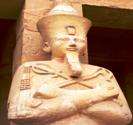 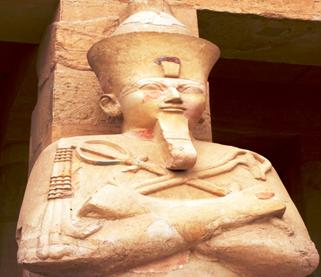
|
| |
| |
|
The
Chapel of Anubis |
|
| |
This chapel is situated
exactly in the same position as the chapel of Hathor,
but on the left hand side of the entrance to the second
terrace of the temple.
The walls of the chapel of Anubis exhibit scenes of the
divine birth of the Queen Hatshepsut. All the rituals of
this holy birth are performed by the god Amun in the
disguise of the father of the Queen, Tuthmosis III.
The chapel of Anubis, the same as the chapel of Hathor, consists of a
hypostyle hall containing 12 columns supporting an
astronomical ceiling. At the end of this hall, there is
also a rock cut sanctuary, which is not open for public.
The most amazing feature of the chapel of Anubis is the
ornaments and decorations of the hypostyle hall which is
almost flawlessly intact.
|
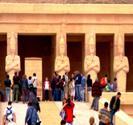 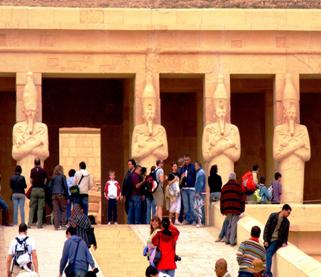
|
| |
| |
|
The
statues of Queen Hatshepsut disguised as a Pharaoh |
|
| |
The tall columns of the
upper terrace of the temple are decorated with
outstanding Osiride statues of the Queen Hatshepsut
represented as a male king with a beard.
Many of these statues were damaged with time passing by.
However, many of them were restored to be in a perfect
shape.
These statues are among the most remarkable elements of
the mortuary temple of Hatshepsut.
|
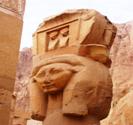 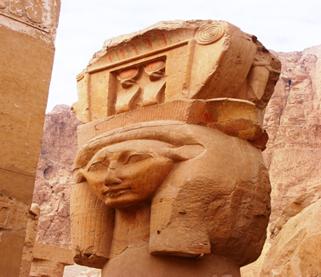
|
| |
| |
|
The Punt
Portico |
|
| |
The most interesting and
most visited part of the temple of Hatshepsut is
so-called punt portico. Located in the Southern part of
the colonnade that closes the second terrace, this
section of the temple is truly fascinating.
The drawings and colorful scenes carved on the walls of
this part of the temple illustrate an expedition mission
that went to the land of Punt, near Nubia, during the
rule of the Queen Hatshepsut. The main objective of
this expedition mission that consisted of five huge
ships was to obtain perfumes and wood from these lands
to be used in the land of the Nile.
History tells us that more than thirty Myrrh trees were
transported from the land of Punt to Luxor to be
transplanted in the Karnak Temple
|
 
|
| |
| |
| |
 |
The
Karnak Temple
In ancient Egypt, the power of the god Amun of Thebes gradually increased during the early New Kingdom, and after the short persecution led by Akhenaten, it rose to its apex. In the reign of
Ramses III, |
 |
|
|
|
 |
The Valley of the Kings
The tombs of the
Valley of the Kings originally contained many other
items that were transferred to the Egyptian Museum
like the royal belongings of the king that he will
use in the afterlife |
 |
|
| |
 |
The Queen Hatshepsut Temple
In a spot sacred to the goddess Hathor in the West Bank of Luxor, situated under the foot of one of the huge Theban Mountains, the Queen Hatshepsut has built her mortuary temple that was so fascinating that was called many names in ancient times |
 |
|
| |
| |
 |
The
Luxor Temple
Located in the heart of the modern city of Luxor, the Luxor temple, especially the two colossi of Ramses II situated at the entrance of the temple, has become a land mark of the city. |
 |
|
| |
 |
The colossi of Memnon
The Colossi of Memnon. One of the main attractions on the West Bank of Luxor, a landmark which everyone passes on the road to the monument |
 |
|
| |
|
 |
 |
 |
 |
 |
 |
 |
Discover Luxor
Do you have plans to travel to Egypt?
A comprehensive Egypt travel offer – of every type, destination and period in Egypt! In addition, |
Luxor Attractions
Luxor attractions and sightseeing attractions in
Luxor . Book Luxor attraction tours
with Select Egypt |
Luxor Holidays
special discount holiday packages offers for
Luxor travel. We give you tailor made holiday deals for
Luxor travel |
Luxor Tours & Excursions
special discount holiday packages offers for
Luxor excursions. We give you tailor made holiday deals for
Luxor travel |
| Read More >> |
Read More >> |
Read More >> |
Read More >> |
|
| |
 |
| |
 |
 |
 |
 |
 |
Luxor Hotels
Choose from over 89
Luxor hotels with huge savings. Whatever your budget, compare prices and read reviews for all our
Luxor hotels |
Luxor Map
Luxor was constructed on the ruins of the ancient city of Thebes, the capital of Egypt during the Pharaonic New Kingdom (1550 – 1069 BC). |
Luxor Monuments
The best monuments of
Luxor . Information about Luxor monuments, landmarks, historic buildings and museums in
Luxor |
| Read More >> |
Read More >> |
Read More >> |
|
| |
| |
|
|
|